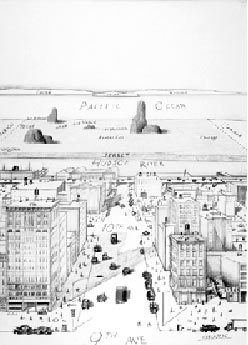'Taxi'.
Romanian-born artist Saul Steinberg arrived in America in 1940, and began to record the life and times of the U.S. As a long-time institution at The New Yorker, Saul Steinberg once declared that his illustrations "masqueraded as cartoons". But coming to his work fresh, one would be hard-pressed to figure out which was the real thing and which was the masquerade.
Saul Steinberg's body of work is a thrilling argument for the utility and effectiveness of cartoon art. His work is a skillful, encyclopedic barrage of technique: deft simplification of line, making thematic points by wording with several perspectives within one drawing, even using progressive imagery to fashion narratives from a single picture, as in his geographical cartoons. On top of his mastery of comics' formal properties, a lot of Steinberg's work is terribly funny, and he exhibited a playfulness best seen in his utilization of methods more commonly found in other arts: automatic writing, paste-ups, and the appropriation of other artists' imagery.
Saul Steinberg had an incalculable impact on dozens of cartoonists. In France, he was an influence on Jean-Jacques Sempé, Siné and Tomi Ungerer, while in The United Kingdom he found followers among Wally Fawkes, Gerald Scarfe and Ronald Searle. In Belgium, he inspired Jijé, Maurice Rosy, Jef Nys, Gal (Gerard Alsteens), Ever Meulen, Hugoké, Joke, Philippe Geluck, Herr Seele, Luc Cromheecke, Jean-Louis Lejeune, Benoît and Steve, In The Netherlands, he is admired by Bob van den Born, Eva Hilhorst, Nico Visscher, Gé Wasco and René Windig & Eddie de Jong. Even Dutch poet Remco Campert at one point in his career drew comics and cartoons with Steinberg as his great example. In the United States, Steinberg has been cited as an inspiration by Jules Feiffer, Sam Gross, Lee Lorenz, Don Martin, Andy Singer and Bill Woodman. In Argentina, he counts Becs, Juan Colombres and Quino among his disciples. In Uruguay he influenced Tabaré. In Azerbaijan, Steinberg inspired Roman Muradov and in Australia Bruce Petty.
'A View of the World From Ninth Avenue', 1976, The New Yorker.



